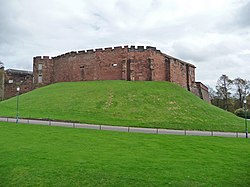Chester Castle
| Chester Castle | |
|---|---|
 Chester Castle | |
| General information | |
| Architectural style | Norman, Neoclassical |
| Town or city | Chester, Cheshire |
| Country | England |
| Coordinates | 53°11′07″N 2°53′32″W / 53.1853°N 2.8923°W |
| Construction started | 1070 |
| Completed | 1822 |
| Design and construction | |
| Architect(s) | Thomas Harrison |
Chester Castle is in the city of Chester, Cheshire, England. It is sited at the southwest extremity of the area bounded by the city walls. The castle stands on an eminence overlooking the River Dee. In the castle complex are the remaining parts of the medieval castle together with the neoclassical buildings designed by Thomas Harrison which were built between 1788 and 1813. Parts of the neoclassical buildings are used today by the Crown Court and as a military museum. The museum and the medieval remains are a tourist attraction.
History
The castle was built in 1070 by

Prominent people held as prisoners in the crypt of the Agricola Tower were
During the

By the later part of the 18th century much of the fabric of the castle had deteriorated and
In February 1867, Irish Fenian Michael Davitt led a group of IRB men from Haslingden on an abortive raid for arms on the castle.[8]
The Army moved in to take hold of the castle and in 1873 a system of recruiting areas based on counties was instituted under the Cardwell Reforms and the castle became the depot for the two battalions of the 22nd (Cheshire) Regiment of Foot.[9] Under the Childers Reforms, the 22nd regiment evolved to become the Cheshire Regiment with its depot in the castle in 1881.[9]
In 1925, after being used for 200 years as a warehouse and ammunition store, the crypt and chapel in the Agricola Tower were
Present day
The complex is entered from Grosvenor Road through the
Further to the right are the remains of the Norman castle. The Agricola Tower is a Grade I listed building. It is built in

To the south and the west, the curtain walls, which include the Halfmoon Tower, the Flag Tower and the gun emplacement, are listed Grade I.
See also
- Governor of Chester
- Siege of Chester
- Castles in Great Britain and Ireland
- List of castles in England
- List of castles in Cheshire
- Grade I listed buildings in Cheshire West and Chester
- Listed buildings in Chester Castle parish
- Norman architecture in Cheshire
- List of Scheduled Monuments in Cheshire (1066–1539)
- List of works by Thomas Harrison
References
Citations
- ^ a b c d e f g h i j Information Sheet: Chester Castle |, Cheshire West and Chester
- ^ St Mary de Castro, Chester, Cheshire, Corpus of Romanesque Sculpture in Britain and Ireland, archived from the original on 5 October 2012, retrieved 13 June 2010
- ^ a b c Northall, John (2006), Chester Castle, Castles of Wales, retrieved 7 March 2008
- ^ a b c Richards 1947, p. 102.
- ISBN 978-1-905119-23-3.
- ISBN 0-904532-46-1
- ^ Pevsner & Hubbard 2003, p. 157.
- ISBN 978-1-84682-265-0.
- ^ a b "Training Depots". Regiments.org. Archived from the original on 10 February 2006. Retrieved 16 October 2016.
- ^ "Military & Wartime Activities during the 20th Century" (PDF). History of Upton by Chester. Retrieved 24 May 2014.
- ^ Historic England, "Propylaea, Chester Castle (1271822)", National Heritage List for England, retrieved 8 April 2012
- ^ Historic England, "Assize Courts Block, Chester Castle (1271823)", National Heritage List for England, retrieved 8 April 2012
- ^ Historic England, "A Block, Chester Castle (1271824)", National Heritage List for England, retrieved 8 April 2012
- ^ Historic England, "B Block, Chester Castle (1245520)", National Heritage List for England, retrieved 8 April 2012
- ^ Historic England, "Agricola Tower, Chester Castle (1271825)", National Heritage List for England, retrieved 8 April 2012
- ^ Pastscape:Agricola Tower, Historic England, retrieved 5 April 2009
- ^ Historic England, "Chester Castle (part) (1006773)", National Heritage List for England, retrieved 8 April 2012
- ^ Historic England, "Curtain wall to west and south west of inner bailey, Chester Castle (1245537)", National Heritage List for England, retrieved 8 April 2012
- ^ Historic England, "Retaining walls and railing of semi circular forecourt, Chester Castle (1245518)", National Heritage List for England, retrieved 8 April 2012
- ^ Historic England, "Curtain wall to east of inner bailey, Chester Castle (1271821)", National Heritage List for England, retrieved 8 April 2012
- ^ Historic England, "Curtain wall to south of inner bailey, Chester Castle (1245539)", National Heritage List for England, retrieved 8 April 2012
- ^ Pevsner & Hubbard 2003, p. 158.
Sources
- ISBN 0-300-09588-0
- Richards, Raymond (1947), Old Cheshire Churches, London: Batsford, OCLC 719918
- Thacker, A. T.; Lewis, C. P., eds. (1945), "Major Buildings: Castle", A History of the County of Chester, Victoria County History, vol. 5, no. 2, University of London & History of Parliament Trust, pp. 204–213, retrieved 27 April 2011


